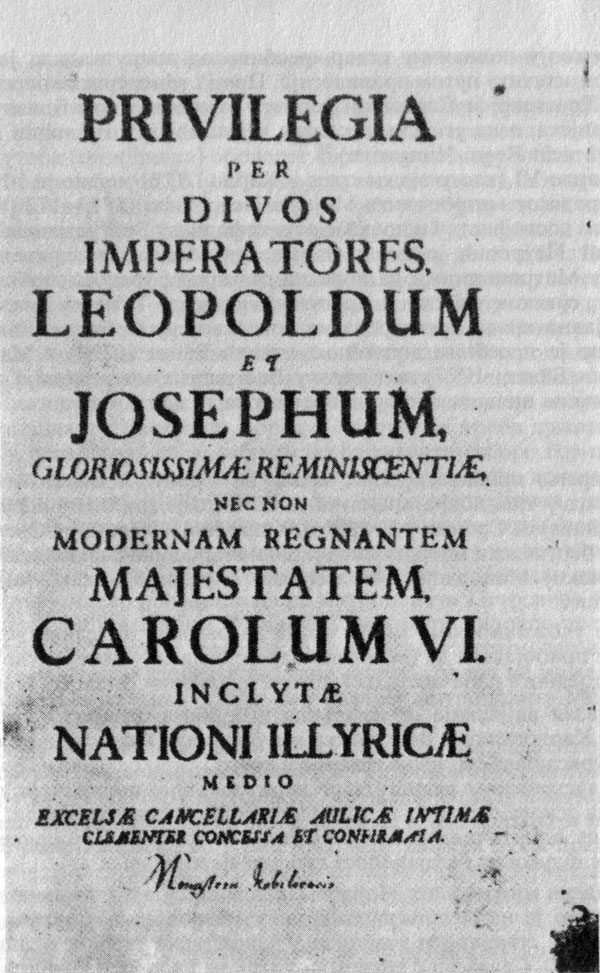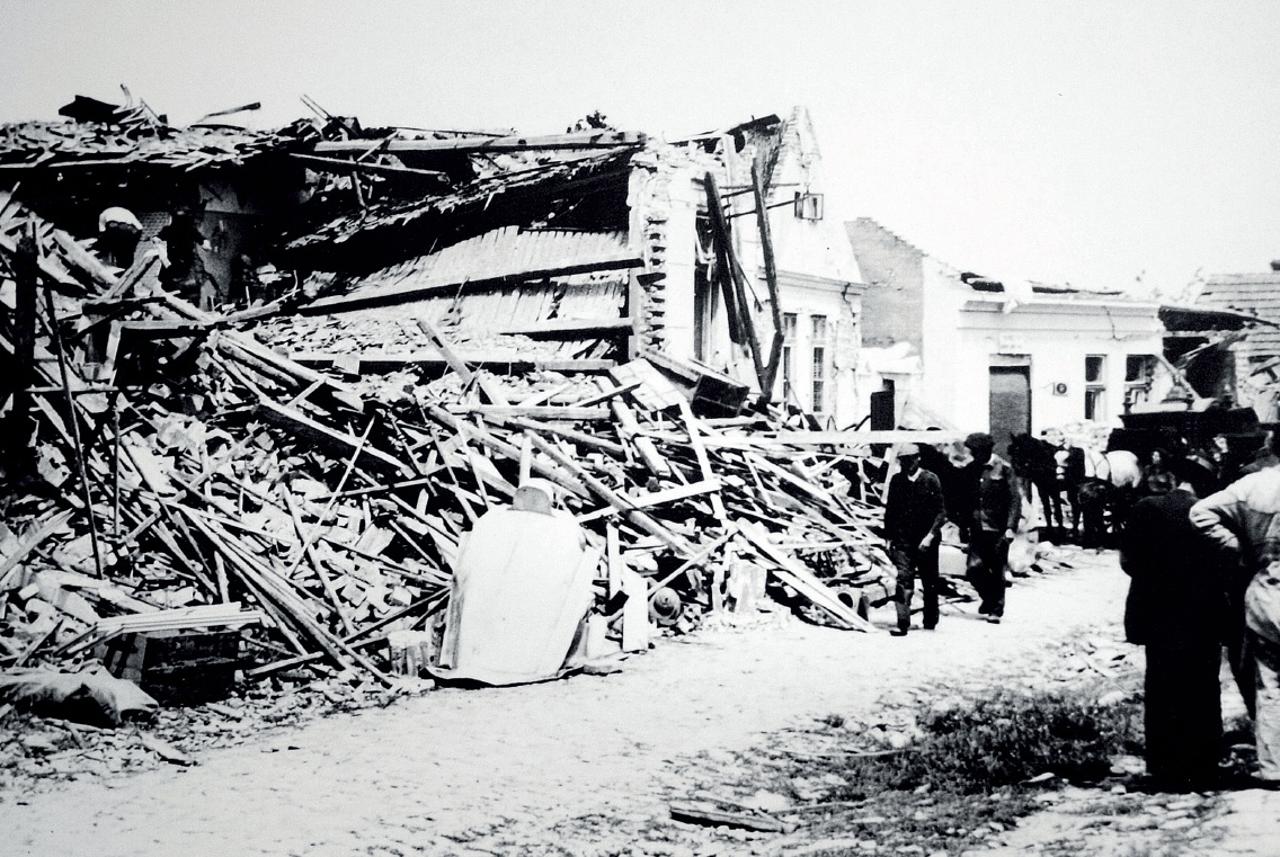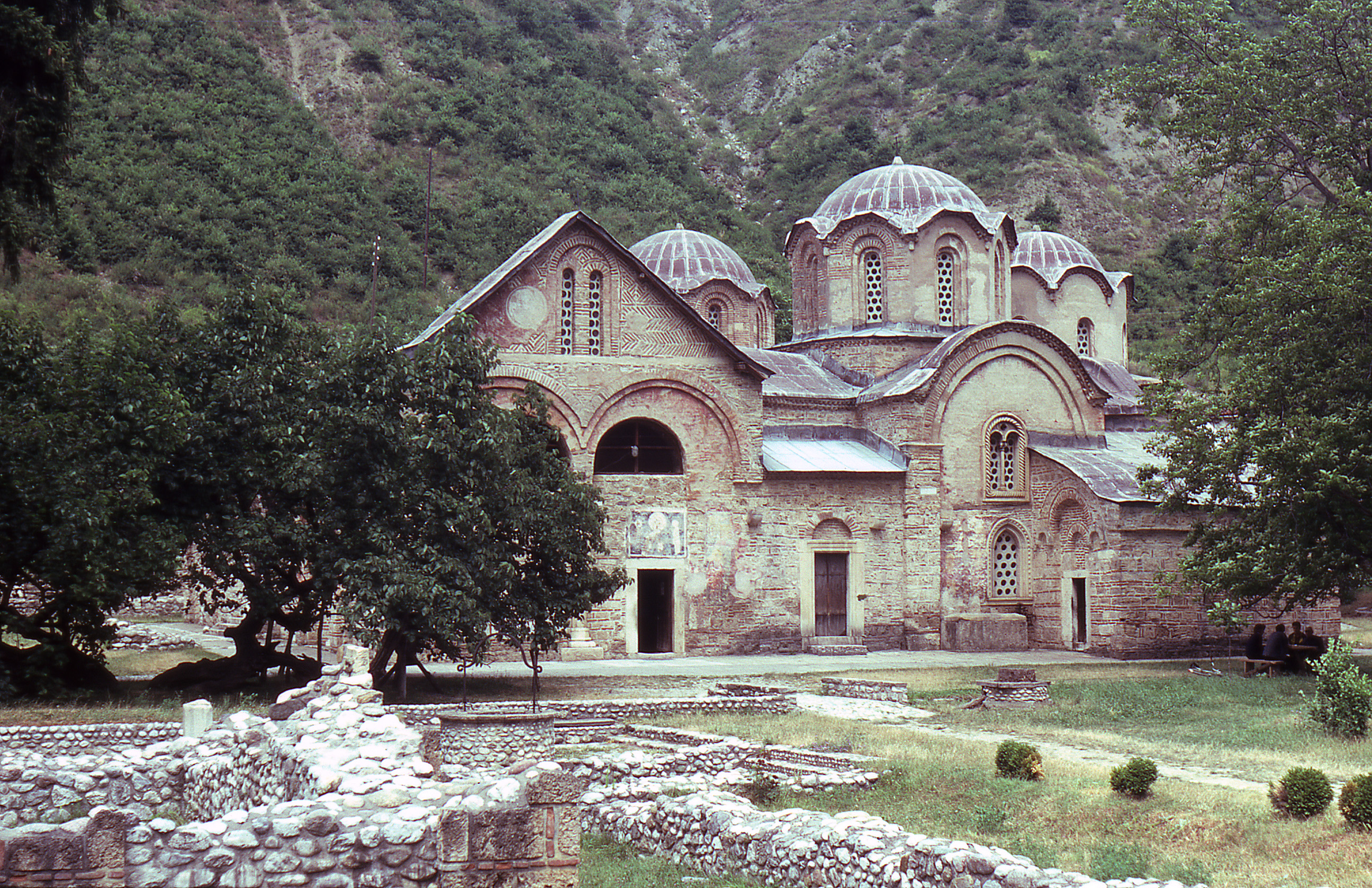|
Isaija Antonović
Isaija II (Antonović), also referred to Isaija II (secular name: Jovan Antonović; 1696, Budapest – 22 January 1749, Vienna), was the eight metropolitan of Karlovci from 1748 until his death in 1749, a significant year for the Serb minority in the Habsburg monarchy. It was a time when the Serbian metropolitan and his subordinates were petitioning Maria Theresa to allow their immigrants from Venetian and Turkish lands to settle, have priests and build churches in the empire. Biography He was born in Budapest in 1696 to a prominent family of merchants and craftsmen who had moved from Novi Pazar to Buda with Patriarch Arsenije III Crnojević. His parents, Antonije and Suzana Antonijević, named him Jovan at his baptism in the Serbian Orthodox Church. The family's financial standing and the cultural and political life of the Serb community at Buda undoubtedly influenced Jovan Antonović's choice after marrying to become a priest and pursue a teaching career. When he became a w ... [...More Info...] [...Related Items...] OR: [Wikipedia] [Google] [Baidu] |
Metropolitanate Of Karlovci
The Metropolitanate of Karlovci () was a metropolitanate of the Eastern Orthodox Church that existed in the Habsburg monarchy between 1708 and 1848. Between 1708 and 1713, it was known as the Metropolitanate of Krušedol Monastery, Krušedol, and between 1713 and 1848, as the Metropolitanate of Sremski Karlovci, Karlovci. In 1848, it was elevated to the Patriarchate of Karlovci, which existed until 1920, when it was merged with the Metropolitanate of Belgrade and other Eastern Orthodox jurisdictions in the newly established Kingdom of Yugoslavia, Kingdom of Serbs, Croats and Slovenes to form the Serbian Orthodox Church. History During the 16th and 17th centuries, all of the southern and central parts of the former medieval Kingdom of Hungary (1301–1526), Kingdom of Hungary were under Turkish rule and organized as Ottoman Hungary. Since 1557, Serbian Orthodox Church in those regions was under jurisdiction of the Serbian Patriarchate of Peć. During the Great Turkish War, Aus ... [...More Info...] [...Related Items...] OR: [Wikipedia] [Google] [Baidu] |
Varaždin Generalate
The Varaždin Generalate (, ), also known as the (" Slavic Border") in German, was a province of the Military Frontier of the Habsburg monarchy (later the Austrian Empire and briefly Austria-Hungary), that existed between 1531 and the 19th century. While the Generalate was originally based in Warasdin (Varaždin), Varaždin County, including the city, was removed from the Military Frontier in the 18th century; the district the Generalate controlled was thereafter centered on Bellowar (Bjelovar), which also briefly acted as its administrative center until it was moved to Zagreb in 1787. The border command was established by Ferdinand I, Holy Roman Emperor in 1531. By the 1560s the Habsburgs established a frontier defense system, made up of six main ''Grenzgeneralat'' (captain-generalcies) in the Military Frontier in Hungary and Croatia, each commanded by captain generals; the one centered in Varaždin was after 1578 known as the Wendish-Bajcsavár captain-generalcy. Until the Long ... [...More Info...] [...Related Items...] OR: [Wikipedia] [Google] [Baidu] |
Metropolitans Of Karlovci
Metropolitans may refer to: Sports *New York Metropolitans (1880–1887), a defunct Major League New Baseball team *New York Mets (1962–present), a Major League Baseball team *Seattle Metropolitans (1915–1924), a Seattle ice hockey team *Bydgoszcz–Toruń Metropolitans (BiT Mets) (2012–present), a Bydgoszcz-Toruń bi-polar agglomeration American football reserve team of Angels Toruń and Bydgoszcz Archers *Metropolitans 92, a basketball team currently playing in France's top men's division, LNB Pro A Other uses * Metropolia, or metropolis, Christian term for the jurisdiction under a Metropolitan bishop In Christianity, Christian Christian denomination, churches with episcopal polity, the rank of metropolitan bishop, or simply metropolitan (alternative obsolete form: metropolite), is held by the diocesan bishop or archbishop of a Metropolis (reli ..., who might also be known as a Metropolitan. See also * Metropolitan (other) {{disambig ... [...More Info...] [...Related Items...] OR: [Wikipedia] [Google] [Baidu] |
1749 Deaths
Events January–March * January 3 ** Benning Wentworth issues the first of the New Hampshire Grants, leading to the establishment of Vermont. ** The first issue of ''Berlingske'', Denmark's oldest continually operating newspaper, is published. * January 21 – The Teatro Filarmonico, the main opera theater in Verona, Italy, is destroyed by fire. It is rebuilt in 1754. * February – The second part of John Cleland's Erotic literature, erotic novel ''Fanny Hill'' (''Memoirs of a Woman of Pleasure'') is published in London. The author is released from debtors' prison in March. * February 28 – Henry Fielding's comic novel ''The History of Tom Jones, a Foundling'' is published in London. Also this year, Fielding becomes magistrate at Bow Street, and first enlists the help of the Bow Street Runners, an early police force (eight men at first). * March 6 – A "corpse riot" breaks out in Glasgow after a body disappears from a churchyard in the Gorbals dist ... [...More Info...] [...Related Items...] OR: [Wikipedia] [Google] [Baidu] |
1696 Births
Events January–March * January 21 – The Recoinage Act, passed by the Parliament of England to pull counterfeit silver coins out of circulation, becomes law.James E. Thorold Rogers, ''The First Nine Years of the Bank of England'' (Clarendon Press, 1887 p. 41 * January 27 – In England, the ship (formerly ''Sovereign of the Seas'') catches fire and burns at Chatham, after 57 years of service. * January 31 – In the Netherlands, undertakers revolt after funeral reforms in Amsterdam. * January – Colley Cibber's play '' Love's Last Shift'' is first performed in London. * February 8 (January 29 old style) – Peter the Great, who had jointly reigned since 1682 with his mentally ill older half-brother Tsar Ivan V, becomes the sole Tsar of Russia when Ivan dies at the age of 29. * February 15 – A plot to ambush and assassinate King William III of England in order to restore King James and the House of Stuart to the throne is foiled ... [...More Info...] [...Related Items...] OR: [Wikipedia] [Google] [Baidu] |
Orthodoxy
Orthodoxy () is adherence to a purported "correct" or otherwise mainstream- or classically-accepted creed, especially in religion. Orthodoxy within Christianity refers to acceptance of the doctrines defined by various creeds and ecumenical councils in Late antiquity, antiquity, but different Churches accept different creeds and councils. Such differences of opinion have developed for numerous reasons, including language and cultural barriers. In the Christian world, Eastern Orthodoxy and Oriental Orthodoxy are sometimes referred to simply as ''"the Orthodox"'' or ''"Orthodoxy"''. In some English-speaking countries, Jews who adhere to all the contemporarily-applicable 613 commandments, commandments legislated in the Torah, Written and Oral Torah are often called Orthodox Judaism, Orthodox Jews. As this can include many Jews that may not necessarily identify with the term ''"Orthodox"'', such as many Conservative Judaism, Masorti Jews, Jewish religious movements, Jewish communi ... [...More Info...] [...Related Items...] OR: [Wikipedia] [Google] [Baidu] |
Pavle Nenadović
Pavle Nenadović ( sr-cyr, Павле Ненадовић, ; 1703–1768) was the Serbian Orthodox Archbishop and Metropolitan of Karlovci from 1749 to 1768. Biography Pavle Nenadović was born on 14 January 1703 in Budim, Hungary. At the age of eighteen, he was employed as a clerk in the Budim Magistrates Office. He became a Serbian Orthodox cleric in 1726, after which he took monastic vows in the Rakovac Monastery. In 1737, Serbian Patriarch Arsenije IV appointed Pavle as his general exarch, and in 1742 the patriarch appointed him as the bishop of the Eparchy of upper Karlovac. Arsenije IV also commissioned Pavle Nenadović, a cleric who was by then well known as a poet, to compose a heraldic handbook, ''Stemmatographia'' (meaning "the drawing of ancestry" in Greek). This heraldic album was modelled after a book of the same title on Slavonic heraldic bearings, engraved in 1701 by Croatian poet Pavao Ritter Vitezović (who modelled his Stemmatographia after an older version o ... [...More Info...] [...Related Items...] OR: [Wikipedia] [Google] [Baidu] |
World War II
World War II or the Second World War (1 September 1939 – 2 September 1945) was a World war, global conflict between two coalitions: the Allies of World War II, Allies and the Axis powers. World War II by country, Nearly all of the world's countries participated, with many nations mobilising all resources in pursuit of total war. Tanks in World War II, Tanks and Air warfare of World War II, aircraft played major roles, enabling the strategic bombing of cities and delivery of the Atomic bombings of Hiroshima and Nagasaki, first and only nuclear weapons ever used in war. World War II is the List of wars by death toll, deadliest conflict in history, causing World War II casualties, the death of 70 to 85 million people, more than half of whom were civilians. Millions died in genocides, including the Holocaust, and by massacres, starvation, and disease. After the Allied victory, Allied-occupied Germany, Germany, Allied-occupied Austria, Austria, Occupation of Japan, Japan, a ... [...More Info...] [...Related Items...] OR: [Wikipedia] [Google] [Baidu] |
Eparchy Of Slavonia
Serbian Orthodox Eparchy of Slavonia ( sr-Cyrl, Српска православна епархија славонска, ) is an eparchy (diocese) of the Serbian Orthodox Church encompassing areas of western and central Slavonia, Croatia. Since 2014, the Eparchy is headed by bishop Jovan Ćulibrk. History During the Middle Ages, the Banate of Slavonia was under the rule of Hungarian kings. By the 15th century, some eastern regions of Slavonia were inhabited by Serbs, who settled there after fleeing Bosnia, even before the Ottoman conquest in 1463. Since Serbs were Eastern Orthodox Christians, some tensions occurred with local Catholic Church. In 1438, pope Eugene IV (1431–1447) sent the inquisitor Giacomo della Marca to Slavonia as a missionary, with instruction to convert "schismatic" Serbs to "Roman religion", and if that should fail, to banish them. During that period, Serbian nobility was also present in the region. In 1454, Serbian Orthodox liturgical book, the Vara� ... [...More Info...] [...Related Items...] OR: [Wikipedia] [Google] [Baidu] |
Pakrac
Pakrac is a town in western Slavonia, Croatia, population 4,842, total municipality population 8,460 (census 2011). Pakrac is located on the road and railroad connecting the regions of Posavina and Podravina. Name In Croatian the town is known as ''Pakrac'', in German as ''Pakratz'', in Hungarian as ''Pakrác''. History The town was first mentioned in 1237. It was captured by the Ottoman Empire in 1543. It was initially a kaza centre in the Sanjak of Pojega between 1543 and 1552, then in the Sanjak of Pakrac in the Rumelia Eyalet between 1552 and 1559. Later it was the centre of the Sanjak of Pakrac between 1559 and 1601, when the sanjak seat was moved to Cernik. The Ottoman rule in Pakrac lasted until the Austrians captured it in 1691. In the late 19th and early 20th centuries, Pakrac was part of the Požega County of the Kingdom of Croatia-Slavonia. Hostilities during the Yugoslav wars in Pakrac began on August 18, 1991, when Serb troops shelled the town from positions ... [...More Info...] [...Related Items...] OR: [Wikipedia] [Google] [Baidu] |
Osijek
Osijek () is the fourth-largest city in Croatia, with a population of 96,848 in 2021. It is the largest city and the economic and cultural centre of the eastern Croatian region of Slavonia, as well as the administrative centre of Osijek-Baranja County. Osijek is on the right bank of the Drava River, upstream of its confluence with the Danube, at an elevation of . Name The name was given to the city due to its position on elevated ground, which prevented the city being flooded by the local swamp waters. Its name ''Osijek'' derives from the Croatian word ''oseka'' ' ebb tide'. Due to its history within the Habsburg monarchy and briefly in the Ottoman Empire, as well as the presence of German, Hungarian, and Serbian minorities throughout its history, Osijek has (or had) its names in other languages: Hungarian: ''Eszék'', German: , or , , and English: ''Esgek''. Its Roman name was ''Aelia Mursa'', ''Mursa'', and later ''Mursa Major'', which may be a form of the pre-existing na ... [...More Info...] [...Related Items...] OR: [Wikipedia] [Google] [Baidu] |
Serbian Patriarchate Of Peć
Serbian Patriarchate of Peć (, ''Srpska patrijaršija u Peći''), or simply Peć Patriarchate (, ''Pećka patrijaršija''), was an autocephaly, autocephalous Eastern Orthodox Patriarchate that existed from 1346 to 1463, and then again from 1557 to 1766 with its seat in the Patriarchal Monastery of Peć. It had ecclesiastical jurisdiction over Eastern Orthodox Christians in Serbian Lands and other western regions of Southeastern Europe. Primates of the Patriarchate were styled ''Archbishop of Peć and Serbian Patriarch''. Medieval Period (1346–1463) Since 1219, the Eastern Orthodox Church in the medieval Kingdom of Serbia (medieval), Kingdom of Serbia was organized as an autocephaly, autocephalous Archbishopric seated at first in the Monastery of Žiča and since the middle of the 13th century in the Patriarchal Monastery of Peć, Monastery of Peć. Political expansion of the Serbian medieval state culminated under the reign of King Stefan Dušan (1331–1355), who conquere ... [...More Info...] [...Related Items...] OR: [Wikipedia] [Google] [Baidu] |





